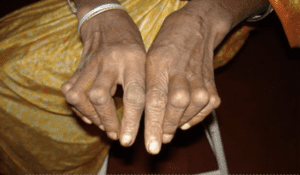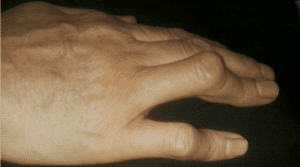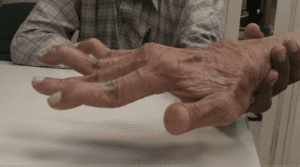Individuals with RA may experience different types of hand conditions, depending on the rate and manner in which their joints and ligaments deteriorate due to the disease.
“All of these changes result from the inflammatory destruction to the joints of the fingers that occur with arthritis, causing increased pain, stiffness, swelling, and limited functional use of the hand for gripping, grasping, and pinching,” said Kristen Gasnick, PT, DPT, whose outpatient rehabilitation practice includes people with RA.
The most common manifestations of RA-caused hand concerns identified by researchers include the following:

Rheumatoid nodules are hard lumps that form under the skin near the joints. These are another common symptom of RA in the hands. They can also occur in multiple areas, most commonly near your elbows. The nodules usually aren’t painful or debilitating, but some people might not like how they look. Rheumatoid nodules are bumps that form under the skin and are commonly seen in hands or elbows. Prashanthns, CC BY-SA 3.0

Less common among people with RA are Heberden nodes and Bouchard nodes. These are visible bumps at the joints that are more typical of osteoarthritis.
Osteoarthritis can cause inflammation of the joints in the hands. Heberden nodes are present in the joint at the end of the finger, called the distal interphalangeal joint. Bouchard nodes are present in the middle joint of the finger, called proximal interphalangeal joint. J. Lengerke 21:37, 27. Mai 2009 (CEST), CC BY-SA 3.0 DE

Boutonniere deformity occurs when the middle or proximal interphalangeal joint of a finger is flexed and the distal joint is extended. Boutonniere deformity is caused by rheumatoid arthritis and inflammation of the joint. Alborz Fallah, CC BY-SA 3.0

Swan-neck deformity, the most common change in people with RA, occurs when there’s weakness or tearing of a ligament due to inflammation. This results in laxity of the middle joint of the finger and flexion of the distal joint.
Swan-neck deformity starts with inflammation of the joint and can progress to destruction of the tendon, which is seen in the progressive disease rheumatoid arthritis. Phoenix119, CC BY-SA 3.0

Hitchhiker’s thumb occurs when the thumb flexes at the metacarpophalangeal joint (connecting the thumb to the palm of the hand) and hyperextends at the interphalangeal joint (the one just below your thumbnail).
This is sometimes also called the Z-shaped deformity.
The availability of effective drugs that limit the progression of RA has helped reduce the severity of RA-related hand deformities. Known as disease-modifying antirheumatic drugs (DMARDs), some of the medications commonly prescribed to treat RA include:
In some cases, rheumatoid nodules have been found to be more common among people receiving methotrexate treatment. They may be reduced in size by changing medications, receiving corticosteroid injections, or undergoing surgery.

Monday- Friday: 8:30AM- 5:00 PM
Saturday- Sunday: Closed